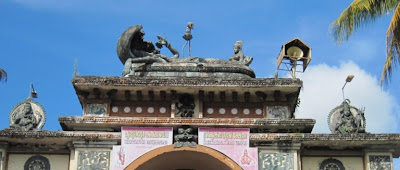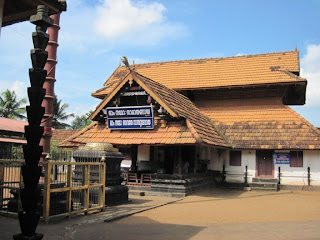பேயாழ்வார் சாற்றுமுறை (5th Nov 2011)
Among the 12 Azhwaars of Srivaishanva Tradition, Poigai Azhwar, Boothath Azhwar and Peyazhwar – were the ones to have decended on this Earth earlier. They were contemporaries and are praised as “Muthal Azhwars (the first among the Azhwars). They were born in the month of “Aippasi: in the thirunakshathirams of ‘Thiruvonam, Avittam, Sathayam’ respectively.
The three of them met on a rainy day at Thirukkovalur – when they sang 100 verses each which now form part of Moonravathu Ayiram (Iyarpa) in Naalayira Divyaprabandham.
Sri Peyalwar was born in a tank in Mylapore (thence known as Mylai Thiruvallikkeni). His birthplace is in the present day Arundel Street in Mylapore closer to Mylai Madhaava Perumal Kovil. At Thiruvallikkeni, the road adjacent to Sri Parthasarathi Kovil houses a separate sannathi (temple by itself) for Sri Peyalwar and the street is named after the Azhwar and is known as ‘Peyazhwar kovil Street’.
On 5th of Nov 2011 was the sarrumurai of Sri Peyalwar. Here are some photos of Mylai Peyalwar (during His earlier visit to Thiruvallkkeni); Lord Parthasaratahi during Aekadasi purappadu yesterday and the avatharasthalam (birthsite) at Mylapore.
[Perumal Aekathasi photos : courtesy Thirumazhisai Kannan]
ஐப்பசியில் ஓணம் அவிட்டம் சதயம் இவை - ஒப்பிலவா நாள்கள் உலகத்தீர் - என ஸ்ரீ மணவாள மாமுனிகள் தமது 'உபதேச ரத்தினமாலையில்' எடுத்து உரைத்தார். இவை எப்புவியும் பேசு புகழ் "பொய்கையார், பூதத்தார், பேயாழ்வார்' - இவ்வுலகில் வந்துதித்த நாள்கள். பன்னிரு ஆழ்வார்களில் முதலில் வந்துதித்ததனால் முதல் ஆழ்வார்கள் என பெருமை பெற்றவர்கள் இவர்கள். ஸ்ரீ மணவாள மாமுனிகள் "உபதேச ரத்தினமாலை"யில் மேலும் :
மற்றுள்ள ஆழ்வார்களுக்கு முன்னே வந்துதித்து *
நற்றமிழால் நூல் செய்து நாட்டை உய்த்த * -
பெற்றிமையோர் என்று முதலாழ்வார்கள் என்னும் பேரிவர்க்கு *
நின்றது உலகத்தே நிகழ்ந்து. -- என சிறப்பித்தார்.
ஐப்பசி சதயம் நட்சத்திரத்தில் பேயாழ்வார் திருமயிலையில் அவதரித்தார். ஒரு காலத்தில் திருவல்லிக்கேணி பிருந்தா அரண்யம் என துளசி காடாக இருந்ததை போலவே, திருமயிலை புதர்கள் மண்டி, மரங்கள் அடர்ந்து காடாக இருந்திருக்கிறது. சிறப்பு வாய்ந்த இந்தத் தலத்தில் மாதவப் பெருமாள் திருக்கோயில் அருகில் உள்ள ஒரு குளத்தில் (கிணற்றில்) அதிசயமான செவ்வல்லி மலரிலே மஹா விஷ்ணுவின் ஐம்படைகளில் ஒன்றாகிய நாந்தகம் எனும் வாளின் அம்சமாக பேயாழ்வார் அவதரித்தார். இவர் அயோநிஜர். இந்த அவதார ஸ்தலம் - இன்று அருண்டேல் தெரு என அழைக்கப் படும் வீதியில் மிக சாதரணமாக உள்ளது.
இவர் அருளிச் செய்த பிரபந்தம் : மூன்றாம் திருவந்தாதி. முதல் ஆழ்வார்கள் மூவரும் ஒரு நல்ல மழை நாளில் திருகோவலுரில் ஒரு இடைகழியில் சந்தித்தனர். முதலில் பொய்கை ஆழ்வார் அங்கே இருந்தார்; பூதத்தாழ்வார் அவ்விடம் வந்தபோது, 'ஒருவர் படுக்கலாம், இருவர் இருக்கலாம்' என இடமளித்தார். பிறகு பேயாழ்வாரும் அங்கே வரவே "ஒருவர் படுக்கலாம், இருவர் இருக்கலாம், மூவர் நிற்கலாம்' என அவரையும் வரவேற்றனர். ஸ்ரீமன் நாராயணன் அவர்களை சோதிக்க எண்ணி தானும் உட்புகுந்த போது, முதலில் பொய்கை ஆழ்வார் "வையம் தகளியா, வார்கடலே நெய்யாக (உலகத்தையே விளக்காகவும் பெரிய கடலை நெய்யாகவும்) கொண்டு நூறு பாடல்கள் பாடினார். பிறகு, பூதத் ஆழ்வார், 'அன்பே தகளியா ஆர்வமே நெய்யாக' (அன்பை விளக்காகவும் ஆர்வமான எண்ணங்களை நெய்யாகவும்) கொண்டு நூறு பாடல்கள் பாடினார்.
இவ்வாறான விளக்குகளில் எம்பெருமானை சேவித்த பேயாழ்வார்
"திருக்கண்டேன், பொன்மேனி கண்டேன், *திகழும்
அருக்கன் அணி நிறமும் கண்டேன்;* செருக்கிளரும்
பொன்னாழி கண்டேன், புரிசங்கம் கைக் கண்டேன்,*
என்னாழி வண்ணன் பால் இன்று" - என நூறு பாடல்கள் பாடினார். இப்பாடல்களே நாம் அனுசந்திக்கும் "மூன்றாம் திருவந்தாதி"
முதலாழ்வார்களின் சாற்றுமுறை வைபவம் திவ்யதேசங்களில் சிறப்பாக நடை பெற்றது. திருவல்லிக்கேணி திவ்யதேசத்தில் ஆழ்வாருக்கு தனி சந்நிதி (தனி கோவில் என்று சொல்லலாம்) அமைந்துள்ளது. ஸ்ரீ பார்த்தசாரதி கோவிலுக்கு வடக்கு பக்கம் கோவிலை ஒட்டி அமைந்துள்ள வீதியில் இந்த கோவில் உள்ளதால், இந்த தெரு "பேயாழ்வார் தெரு". பழமையான இந்த சன்னதி தற்போது புனர் அமைக்கப்பட்டு வருகிறது. திருவல்லிக்கேணி ஸ்ரீ மணவாளமாமுனிகள் சபையார் இத்திருப்பணிகளை செய்து வருகின்றனர். திருப்பணி வேலைகள் நடைபெறுவதால் ஸ்ரீ பேயாழ்வார் உத்சவர், ஸ்ரீ பார்த்தசாரதி கோவில் உள்ளே எழுந்து அருளி உள்ளார்.
சென்னை மற்றும் சுற்றுபுறங்களில் தொடர்ந்து பெய்து வரும் மழை காரணமாக, சாற்றுமுறை புறப்பாடு(5/11/2011 Eve) மிகவும் வேகமாக நடைபெற்றது.
அடியேன் ஸ்ரீனிவாச தாசன்.
திருமயிலை பேயாழ்வார் திருவல்லிக்கேணி எழுந்து அருளிய போது
ஸ்ரீ பார்த்தசாரதி ஏகாதசி புறப்பாட்டின் போது
அருண்டேல் தெருவில் உள்ள ஸ்ரீ பேயாழ்வார் அவதாரஸ்தலம்
அவதார ஸ்தலத்தில் மண்டபமும் ஆழ்வார் அவதரித்த கிணறும்


















